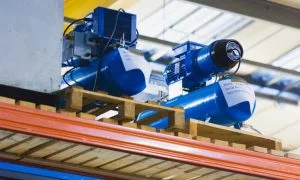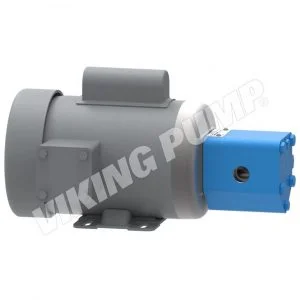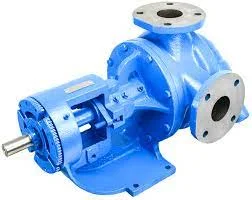 CFM or Cubic Feet Per Minute of air flow is a term that is often confusing in compressed air systems. It is also seen as SCFM, ACFM, and ICFM. So what are the differences?
CFM or Cubic Feet Per Minute of air flow is a term that is often confusing in compressed air systems. It is also seen as SCFM, ACFM, and ICFM. So what are the differences?
SCFM or Standard Cubic Feet Per Minute is referenced to cubic foot of air at standard pressure, temperature, and relative humidity. In most cases, SCFM is based on 14.7 PSIA, 68°F, and 36% relative humidity. By these specific parameters, the density of a cubic foot of air is fixed. The mass flow of compressed air is therefore clearly defined.
ACFM or Actual Cubic Feet Per Minute is volume air that is constantly changing due to atmospheric conditions and/or compressed or expanded by air compressors or vacuum pumps. As temperature increases, the volume expands. As pressure increased the volume decreases. And vice-versa.
P1V1=P2V2 Boyle’s Law, with constant temperature, absolute volume changes with pressure
V1/T1=V2/T2 Charles’ Law, with constant pressure, volume changes with temperature.
ICFM or Inlet cubic feet per minute is a unit adopted by equipment manufactures as it relates to a volume air that can be displaced by the equipment. The actual mass of the inlet air varies with atmospheric conditions. The actual discharge volume varies with pressure and temperature.
If the inlet conditions happen to be at 14.7 PSIA, 68°F, and 36% relative humidity (standard conditions), a 1000 ICFM compressor at 100PSIG would produce 1000SCFM at the discharge. But when you convert that to ACFM (14.7psia X 1000CFM)/114.7psia = 128ACFM at the discharge (assuming constant temperature). From atmospheric pressure, you have compressed the air 7.8 times to 100PSIG.
As often misunderstood, this compressor example does not discharge 1000CFM but rather takes it in the inlet.
Still need more clarification? Read on for more information about CFM vs. SCFM.
 Get Longer Life from Your Internal Gear Pumps
Get Longer Life from Your Internal Gear PumpsOver the last several months I have run into several user misconceptions about internal gear pumps.
These three common errors can reduce the life and capabilities of your internal gear pumps.
First: Bump starting the pump to check rotation.
This is a common practice among maintenance crews. They will turn over the motor to check and see if they have the rotation going in the right direction. The problem is, they have already attached the pump to the motor. Internal gear pumps cannot operate dry. I saw this while visiting a customer last week. They “bump started” the pump to check rotation. Since there was no product in the pump the rotor rubbed against the casing and created some scaring on the casing. Dry starting a pump with mechanical seals can also ruin the seals. Fortunately for this customer they did not damage the seal.
Second: Internal gear pumps create suction.
I have several customers that use internal gear pumps to unload trucks with various products. Inevitably they start the pumps and expect the pump to pull the product from the truck. Internal gear pumps are not self-priming. Internal gear pumps need a flooded head in order to start pumping product. Once the product is at the pump, then they will create suction. It has the same principle as siphoning something using a hose. Once product has been pulled into the hose the flow creates suction to pull the rest of the product out. Plus you need to remember, don’t start the pump dry.
Third: My packing seal will not stop leaking.
I get this all the time. Maintenance guys will take me to a pump and ask why it leaks. The first thing I check is if it has packing for the seal. Packing is made to leak some. By letting the fluid come thru the packing, it will keep it lubricated so as not to dry out and scar the shaft. One thing a lot of people will do to try and stop the leak is tighten the retaining bracket. This is also a no no. Tightening the bracket can also damage the pump. There are different style packing that can reduce leaking but in general packing is made to leak. If it is necessary to stop all leaking you will need a mechanical seal. Depending on the type pump, you may need to change styles in order to get the mechanical seal.
Avoiding these three mistakes can significantly increase the life of your pump and make sure you are able to maintain the performance capabilities of the pump.
 Effective Ways to Protect Your Pumping Process
Effective Ways to Protect Your Pumping ProcessAs a pump applications engineer, oftentimes I find myself immersed in characteristics of a fluid being pumped or customer flow requirements or a myriad of other pump package design conditions. While all these details are pertinent to delivering a properly functioning package, I must also remind myself that this package will be but a small component in a larger working whole.
A package may be simply transporting raw material from a truck to a storage tank or it may be supplying precise quantities of a single additive to a mixing tank filled with other additives. If a single, critical component (such as your pump) fails, the success of the operation is in jeopardy until a solution can be implemented. While some failures are outside of our control, it is my job to limit the risk of preventable failures from causing larger problems. That is the sole reason I quote a strainer on every pump package.
The risk of a bolt, rag or a UFO (unidentified foreign object) becoming lodged in a pump is effectively zero when a properly sized strainer and basket perforation is utilized. For the fraction of the cost of a pump repair, loss of production due to downtime, extra man hours, and/or expedited repair parts, a strainer can be added onto the suction piping to eliminate the threat of these costly outcomes.
Strainers do require regular maintenance to clean out any debris collected, however, the strainer pays for itself after the first chunk of metal or UFO is pulled from the basket. Not only does this limit any damage on the pump, it keeps the production line moving, product flowing, and plant managers happy.
Viking Lidease strainers and y-strainers are basic types that require the pumps to be shut down for maintenance. Duplex strainers can be utilized in situations where shutting down the pumps is not feasible. One basket of the strainer can be cleaned out while flow is diverted to the other basket. This eliminates down time while continually protecting the pumps from foreign materials.
If you are interested in adding strainers to your current pump processes or future applications, feel free to contact me and we can discuss the best suited option for your situation.
Be sure to check out our previous blog post on strainer placement to be sure you don't cause any issues in flow to your pump.
Many customers have to submit for corporate / management budgetary pricing for new or replacement compressed air equipment for pending fiscal budget approval. This monetary amount is compiled for the estimated costs of replacement compressed air equipment or based on estimated additional air required for pending production processes.
With improved technology relating to compressed air audits being able to report current compressed air operation with actual air and pressure requirement for typical daily or weekly operation, determining if existing compressed air system is controlled properly, energy costs of existing equipment, and savings that can be made via an air leak audit and leak repairs that can reduce actual air demand for pending air requirements, below are a few items customers (large and small) should consider with compressed air equipment purchase.
If customers review the power costs of equipment in their plants, they will see that the compressed air equipment is most likely the biggest user and the discussed air leak audit or air system audit will provide a better understanding of current air requirements and / or if additional equipment is needed. If air demand varies during a typical day, an air audit will also assist with adding additional air storage for intermittent needs or show that a variable speed air compressor may be best option versus adding an additional fixed speed air compressor.


